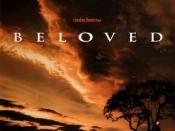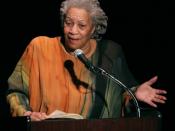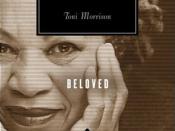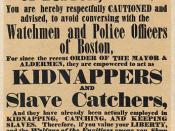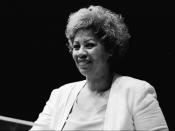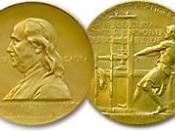History of Century Myth is a fable, an allegory, a legend or a parable as the dictionary describes it. But, there are many other meaning behind a myth told by our elders and in our literature. After hearing a myth, one cannot stop the effect in his/her outlook on life, always wondering what if it was to be a proven fact. Indeed, it would change our views or at least entertain a different point of view of a scenario before dismissing it. Toni Morrison's book, "Beloved"ÃÂ, is a good example of few myths. Mr. Morrison raises a question, is freedom a fact or just a myth. He gives us few parables that make us think what if they actually happened. Would we side with the mother's decision to take her baby's life instead of living through the same harsh slavery conditions she lived through? Or, would we condemn her for her actions not allowing the baby to strive for freedom for herself? Beloved's return from her murdered death is the step needed for Sethe to forgive herself and move on with her life.
Forgiveness from Beloved does not happen however, not allowing Sethe to let her past remain behind her. "Beloved endeavors to transcend the restrictive notion of time, invoking the supernatural as both a figurative and actual means to reunion with the past." (Heinze 181).
When slavery has torn apart one's heritage, when the past is more real than the present, when the rage of a dead baby can literally rock a house, then the traditional novel is no longer an adequate instrument. And so Pulitzer Prize-winner Beloved is written in bits and images, smashed like a mirror on the floor and left for the reader to put together. In a novel that is hypnotic, beautiful, and elusive, Toni Morrison portrays the lives of Sethe, an escaped slave and mother, and those around her. There is Sixo, who "stopped speaking English because there was no future in it," and Mister, the overseer who defines slaves in terms of "human" and "animal" characteristics. There is Baby Suggs, who makes her living with her heart because slavery "had busted her legs, back, head, eyes, hands, kidneys, womb and tongue;" and Paul D, a man with a rusted metal box for a heart and a presence that allows women to cry. At the center is Sethe, whose story makes us think and think again about what we mean when we say we love our children or freedom. The stories circle, swim dreamily to the surface, and are suddenly clear and horrifying. Because of the extraordinary, experimental style as well as the intensity of the subject matter, what we learn from them touches at a level deeper than understanding (Bauermeister, Great books by Women) After reading "Beloved"ÃÂ, one cannot help but feel all of the emotions that Sethe must have felt living through such hardship and the battle for freedom. It also makes one appreciate the freedom he/she has now and raises a question is freedom itself a myth? There is no true freedom in life. We are bound to serve others most of our adult lives. We serve our parents, our management at work, our spiritual leader, our children and so on. Humanity is blessed with intelligence but cursed by it as well. We make choices in life very different from one another and judge others more then ourselves.
I certainly thought I knew as much about slavery as anybody," Morrison told the Los Angeles Times. "But it was the interior life I needed to find out about." It is this "interior life" in the throes of slavery that constitutes the theme of Morrison's Pulitzer Prize-winning novel, Beloved. Set in Reconstruction-era Cincinnati, the book centers on characters who struggle fruitlessly to keep their painful recollections of the past at bay. They are haunted, both physically and spiritually, by the legacies slavery has bequeathed to them. The question in this novel, Morrison told PBS host Charlie Rose, was "Who is the beloved? Who is the person who lives inside us that is the one you can trust, who is the best thing you are. And in that instant, for that segment, because I had planned books around that theme, it was the effort of a woman to love her children, to raise her children, to be responsible for her children. And the fact that it was during slavery made all those things impossible for her." (Gale Research, 1993) Sethe ran for freedom to the free state of Ohio and believed she was free of slavery for the rest of her life. She enjoyed the best 28 days of her life up to that point. But soon, her freedom would turn into an illusion. In mid eighteen hundreds, some of the northern states adopted constitution to free slaves. But, at the same time, they could not harbor any runaway slaves due to the Fugitive Slave Act of 1850. On the 29th day, Sethe notices the white men coming down the street on carriages accompanied by men in uniforms. They were the men to reclaim their slaves, Sethe and her four children. Seth ran to the shed taking her children with her. She had attempted to slay all of them, so that the slave owner would not take them away. She successfully took the life of one baby girl and attempted to kill the others. Seeing this act of brutality, the white men perhaps felt the cost the slaves would go through to achieve freedom. So, they set her free. But, is this the freedom she wanted? The baby girl she killed haunted the house she lived in. Her two sons could not stand the haunted house after a while and ran away from home. Sethe was left with only one daughter (Denver), who also despised her.
There are alot of other things to love, but none of them have currency these days. Loving God, now that's fanatical.
Loving your country, your school, your children. It all has some sort of taint that's Freudian. So the only one that's sort of untainted, the one that everybody thinks is strong and self-important, is loving the other person. And very seldom can that other person bear the weight of all your attention. (Taylor-Guthrie 196) Sethe found an old friend (Paul D) that she grew up with as slaves in the same house. They fell in love but the dead baby's spirit goes on a rampage trying to get red of her mother's newfound love. Paul D. wins the battle but looses the war. The dead baby comes in flesh as a grown woman at the age if she had lived. She called herself Beloved. None of them recognized her as the baby girl that was killed. They thought they were helping a runaway slave, so they let her live in the house. After a short while, Beloved sleeps with her mother's lover and slowly shows him the truth about Sethe. He too would leave after finding out the tale of Sethe's brutal act of murder. Few days later, Sethe notices a cut on Beloved's throat and realized that this was her baby girl. She was joyous and started celebrating the re-union. She was late to work the next day and lost her job. She fell ill short after. She no longer earned income to feed the girls and Beloved went on a rampage again and tore the house up like a tornado punishing her mother for taking her life. The joy in the house was short lived.
Although, these transformations of Sethe, Denver, and Paul D take place at the end of the novel,it was part of Morrison's master plan for her novel, Beloved. Morrison withholds from the reader Beloved's raison d'etre- why she finally makes an appearance, why she changes physically and emotionally, and why she ultimately disappears. The answer to this particular mystery lies in the ability of her characters and readers to reintegrate and reconcile past and present. (Heinze 176).
Now, one cannot help but come to the conclusion that freedom was just a myth for Sethe in more ways than one. She received her freedom for a short while from slavery but almost lost it again. She was forced to sacrifice the life of her child to earn freedom for herself and her children. She only earned a limited freedom. She had to live in a house haunted by her baby girl's ghost. No one would visit her. She found a friend, but that did not last for long either. She got her daughter back for a short while only to realize she was paying the price of taking her life.
Work Cited Erica Bauermeister, 500 Great Books by Women http://www.cob.montevallo.edu/student/HatcherCL/BELOVED.HTM Heinze, Denise. The Dilemma of 'Double Consciousness" Toni Morrison's Novels. University of Georgia Press: Athens, 1993 Kennedy, X.J, and Dana Gioia, eds. "Myth and Narrative."ÃÂ New York: Longman. 1999 "Morrison, Toni," Contemporary Authors, Gale Research, 1993 Morrison, Toni. Beloved. New York, Penguin Books USA Inc, 1988.
Taylor-Guthrie, Dannille, ed. Conversations With Toni Morrison. Jackson: University Press of Mississippi, 1994
